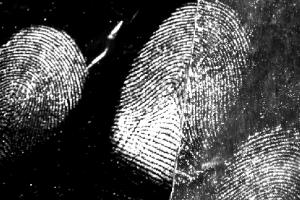Home > Press > A step towards a revolution in law enforcement
 |
| Latent fingermarks from a male donor developed on aluminium foil. Image provided by Xanthe Spindler |
Abstract:
In summary:
- UTS forensic science researcher Dr Xanthe Spindler has achieved a world first with the preliminary development of a novel immunogenic method that could recover usable fingerprints from old evidence and difficult surfaces
- It is also a step in pursuit of the "Holy Grail" of a reliable method for recovering fingerprints from human skin
A step towards a revolution in law enforcement
Sydney, Australia | Posted on June 6th, 2011Despite fingerprinting being essentially the foundation technique of modern forensic science, only a fraction of all the fingermarks at a crime scene are actually detected.
Now the work of UTS forensic science researcher Dr Xanthe Spindler has made an important step towards recovering usable fingerprints from old evidence and surfaces long considered too difficult by crime scene investigators.
The collaboration between the UTS Centre for Forensic Science, the University of Canberra, the Australian Federal Police and Northern Illinois University has resulted in a forensic science world first with the preliminary development of a novel immunogenic method to detect latent fingermarks.
The new method developed by Dr Spindler as part of her PhD work uses antibodies designed to target amino acids and can detect aged, dry and weak fingerprints that can't be captured using traditional fingerprinting methods.
"We've been able to successfully target amino acids on non-porous surfaces for the first time, with promising results in enhancing aged and degraded fingermarks that typically give poor results with traditional powdering and cyanoacrylate fuming," Dr Spindler said. "The potential is there to go back to old cases to see what might now be recovered."
Recently published in Chemical Communications, a journal of the Royal Society of Chemistry, the work is also a step in pursuit of the "Holy Grail" as Dr Spindler calls it, a reliable method for recovering fingerprints from human skin.
"Current techniques of powdering and fuming have never worked well on skin, with the ability to only enhance fingermarks less than three hours old," Dr Spindler said.
"The use of immunogenic reagents targeted at specific markers in body fluids will improve the ability to enhance fingermarks on problematical surfaces such as human skin.
"On other surfaces existing methods are most effective recovering fresh fingermarks that contain a reasonable level of moisture. That has meant that people with dry skin are weak donors and evidence is rapidly degraded in dry conditions or after long storage.
"The targeting of amino acids in fingerprint detection has been around since the mid-'50s, but its use has been limited largely to porous surfaces like paper because of the fragility of amino acid secretions on non-porous surfaces.
"Our work has been a proof-of-concept for a reagent that links amino acid-binding antibodies to gold nanoparticles, with the nanoparticles giving sharper detail in developed fingerprints."
With the support of the Australian Federal Police it is hoped to build on the results to develop a reliable and cost-effective technique with the potential to deliver "transformational outcomes for law enforcement."
In addition to Dr Spindler, chief investigators and key personnel have included the Director of the UTS Centre for Forensic Science Professor Claude Roux, Professor Chris Lennard from the University of Canberra, Professor Oliver Hofstetter from Northern Illinois University and Dr Andrew McDonagh from UTS.
####
For more information, please click here
Contacts:
(Media enquiries)
Terry Clinton
(+61 2 9514 1623)
Copyright © University of Technology, Sydney
If you have a comment, please Contact us.Issuers of news releases, not 7th Wave, Inc. or Nanotechnology Now, are solely responsible for the accuracy of the content.
| Related News Press |
News and information
![]() Researchers develop molecular qubits that communicate at telecom frequencies October 3rd, 2025
Researchers develop molecular qubits that communicate at telecom frequencies October 3rd, 2025
![]() Next-generation quantum communication October 3rd, 2025
Next-generation quantum communication October 3rd, 2025
![]() "Nanoreactor" cage uses visible light for catalytic and ultra-selective cross-cycloadditions October 3rd, 2025
"Nanoreactor" cage uses visible light for catalytic and ultra-selective cross-cycloadditions October 3rd, 2025
Law enforcement/Anti-Counterfeiting/Security/Loss prevention
![]() Chainmail-like material could be the future of armor: First 2D mechanically interlocked polymer exhibits exceptional flexibility and strength January 17th, 2025
Chainmail-like material could be the future of armor: First 2D mechanically interlocked polymer exhibits exceptional flexibility and strength January 17th, 2025
![]() With VECSELs towards the quantum internet Fraunhofer: IAF achieves record output power with VECSEL for quantum frequency converters April 5th, 2024
With VECSELs towards the quantum internet Fraunhofer: IAF achieves record output power with VECSEL for quantum frequency converters April 5th, 2024
![]() Researchers’ approach may protect quantum computers from attacks March 8th, 2024
Researchers’ approach may protect quantum computers from attacks March 8th, 2024
Discoveries
![]() Researchers develop molecular qubits that communicate at telecom frequencies October 3rd, 2025
Researchers develop molecular qubits that communicate at telecom frequencies October 3rd, 2025
![]() Next-generation quantum communication October 3rd, 2025
Next-generation quantum communication October 3rd, 2025
![]() "Nanoreactor" cage uses visible light for catalytic and ultra-selective cross-cycloadditions October 3rd, 2025
"Nanoreactor" cage uses visible light for catalytic and ultra-selective cross-cycloadditions October 3rd, 2025
Research partnerships
![]() Lab to industry: InSe wafer-scale breakthrough for future electronics August 8th, 2025
Lab to industry: InSe wafer-scale breakthrough for future electronics August 8th, 2025
![]() HKU physicists uncover hidden order in the quantum world through deconfined quantum critical points April 25th, 2025
HKU physicists uncover hidden order in the quantum world through deconfined quantum critical points April 25th, 2025
|
|
||
|
|
||
| The latest news from around the world, FREE | ||
|
|
||
|
|
||
| Premium Products | ||
|
|
||
|
Only the news you want to read!
Learn More |
||
|
|
||
|
Full-service, expert consulting
Learn More |
||
|
|
||








